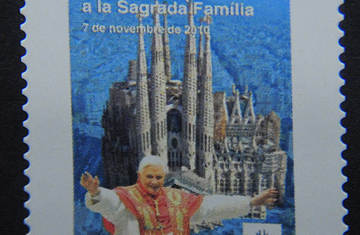
A commemorative stamp celebrating the anticipated visit by Pope Benedict XVI, is displayed at the Sagrada Familia museum in Barcelona, Spain
Jordi Bonet never thought he would see the day. When the Barcelona architect was put in charge of overseeing construction on Antoni Gaudí's famous — and famously unfinished — Sagrada Familia church 26 years ago, he believed that at best he would be able to finish the domed ceiling that caps the nave. But now the interior is almost complete, and the church is preparing to play host to Pope Benedict XVI, who will consecrate the basilica on Sunday. Though not before a building whose entire history has been studded with controversy goes through one more round.
When the Pope leads Mass at the newly complete altar — made, as part of Bonet's design, from a purplish stone called porphyry — 6,500 faithful, including 1,000 priests, will pray with him. For Bonet, who plans to be among the worshipers, the consecration is a triumph. "It's a great satisfaction," he says. "It shows that Sagrada Familia is truly a universal temple."
Others, however, don't see the papal benediction quite so benignly. The Atheists of Catalonia organization has revived its recent advertising campaign for the occasion — "Probably, God doesn't exist," say posters pasted on the sides of public buses; "Stop worrying and enjoy life" — and plans to hold a protest outside the new basilica on Sunday, as do several feminist groups. To get there, they'll have to fight their way through the gay and lesbian couples locking lips for a two-minute "kiss-in." One consortium, the Secular and Progressive Movement, has already gotten the protests underway with a 3,000-strong demonstration held Thursday in Sant Jaume square, the seat of Catalan government. "Spain and Catalonia are pluralist," says Joffre Villanueva, secretary general of the association. "No single religious or moral code should be allowed to dominate the public space."
It's for that reason that one political party within the Catalan government, Catalan Green Initiative (ICV), has mounted its own protest. With expenses for the papal visit expected to reach €700,000 ($990,000), and Spain still deep in recession, ICV leader Joan Herrera called on the Catalan government to pay only the security costs of the pope's visit — just as it would for any foreign head of state — and not the expenses associated with the Mass, including the construction of a press center. "We're losing the perspective of an aconfessional state," he said in a radio interview earlier this week. The members of his party who form part of the regional cabinet have refused to attend the service.
With that kind of controversy awaiting the Pope, perhaps it should not have come as a surprise that he began his visit to Spain Saturday by bemoaning what he views as the country's anti-church sentiment. "In Spain, a strong, aggressive lay mentality, an anticlericalism and secularization has been born as we experienced in the 1930's," Benedict said on his way to Santiago de Compostela, the pilgrimage destination whose cathedral is said to hold the remains of St. James the Apostle.
Yet some local politicians, even the left-leaning ones, have found reason to celebrate the Pope's visit. Barcelona mayor Jordi Hereu, of the Catalan Socialist Party, counters that the benefits to the city will far outweigh the costs. "The economic value of the trip has been estimated at €30 million ($40 million), four million of which will go to promoting Barcelona's international image," he says. "Compare that with the amount the city is spending, and the numbers speak for themselves. The balance is totally positive."
And this being the famously nationalist Catalonia, there's another reason Mayor Hereu and other politicians are pleased: the Pope will conduct part of the service in Catalan. Last week the mayor issued an order urging Barcelonans to hang the Catalan — not the Spanish — flag from their balconies in honor of the papal visit. "In recognition," Hereu tells TIME, "of our status as the Catalan capital." Even the archbishop of Barcelona has welcomed the visit as evidence of a "sweet moment between the Vatican and the Catalan church," a statement that has thrust him into his own mini-debate with Cardinal Antonio Maria Rouco. "There is no Catalan church," replied Isidoro Catela, spokesman for the Madrid-based Spanish Bishop's Conference, of which Rouco is the head. "There is only the universal Catholic church."
In many ways, all of this disagreement is fitting, as Sagrada Familia has provoked controversy from the start. Admittedly, much of it has been aesthetic: Gaudí's 1883 designs for the building were so over-the-top that some contemporary critics were appalled, and even the surrealist Salvador Dali complimented him on his "superbly creative bad taste." When Gaudí died in 1926 after an unfortunate run-in with a streetcar, the church was only partially constructed, and later generations would debate whether his vision, laid out in detailed studies and models that were destroyed during Spain's Civil War, was being faithfully upheld. In the 1990s, many objected to the contemporary — and anatomically correct — figures with which sculptor Josep Maria Subirachs has adorned the church's façade. And in the past few years, the church has been the focus of a different kind of dispute, as supporters mounted a campaign to stop construction of a high-speed rail line whose proximity, they feared, would damage the structure.
No doubt the clashes will continue long after Benedict XVI climbs into the Popemobile on Sunday and waves goodbye. After all, there's still quite a lot of Sagrada Familia's exterior to finish, including its main spire. "I have no idea when it will be complete," says the architect Bonet, who is 85 years old. "But I'm sure it'll be in good hands."
- with reporting by the Associated Press
